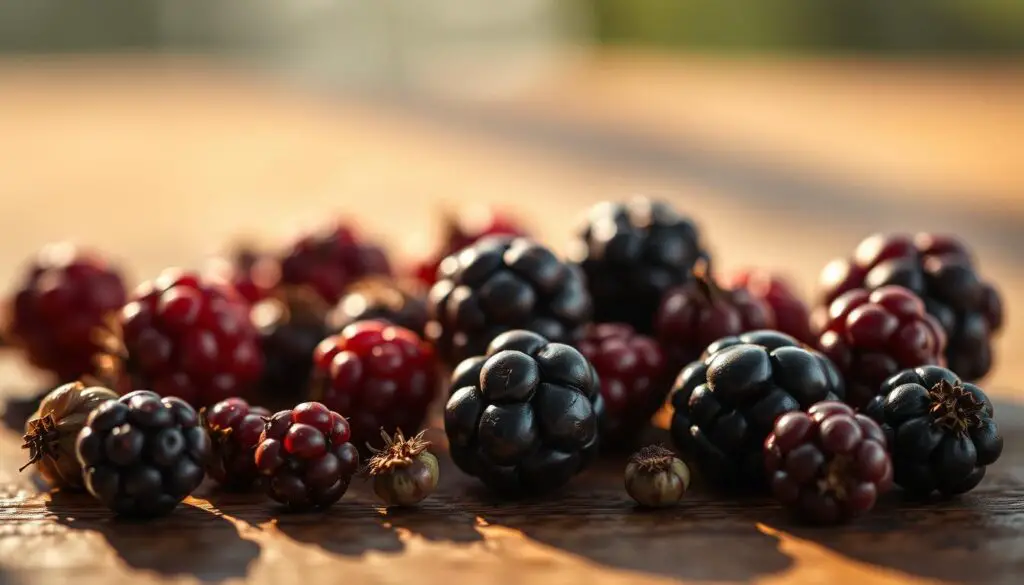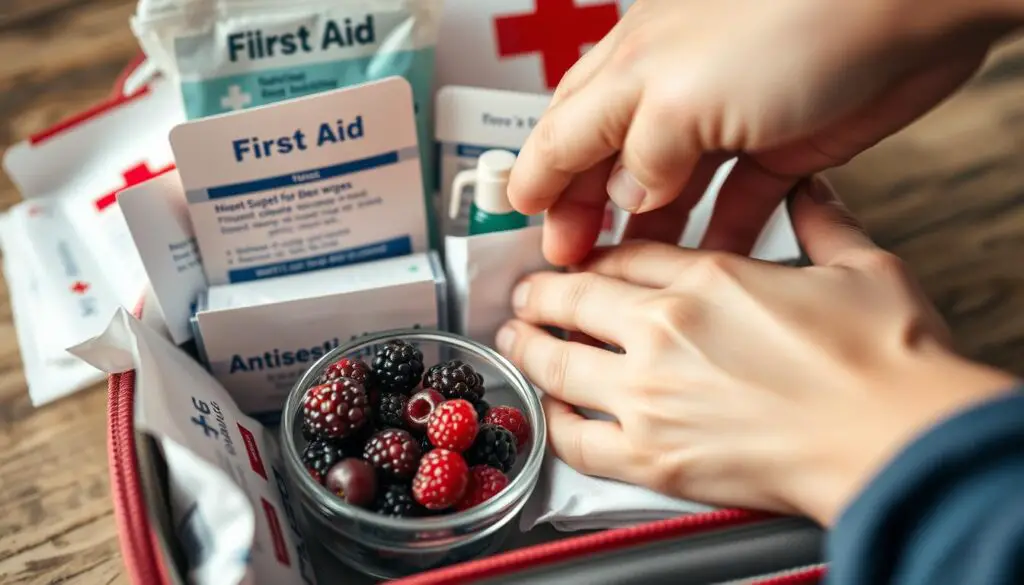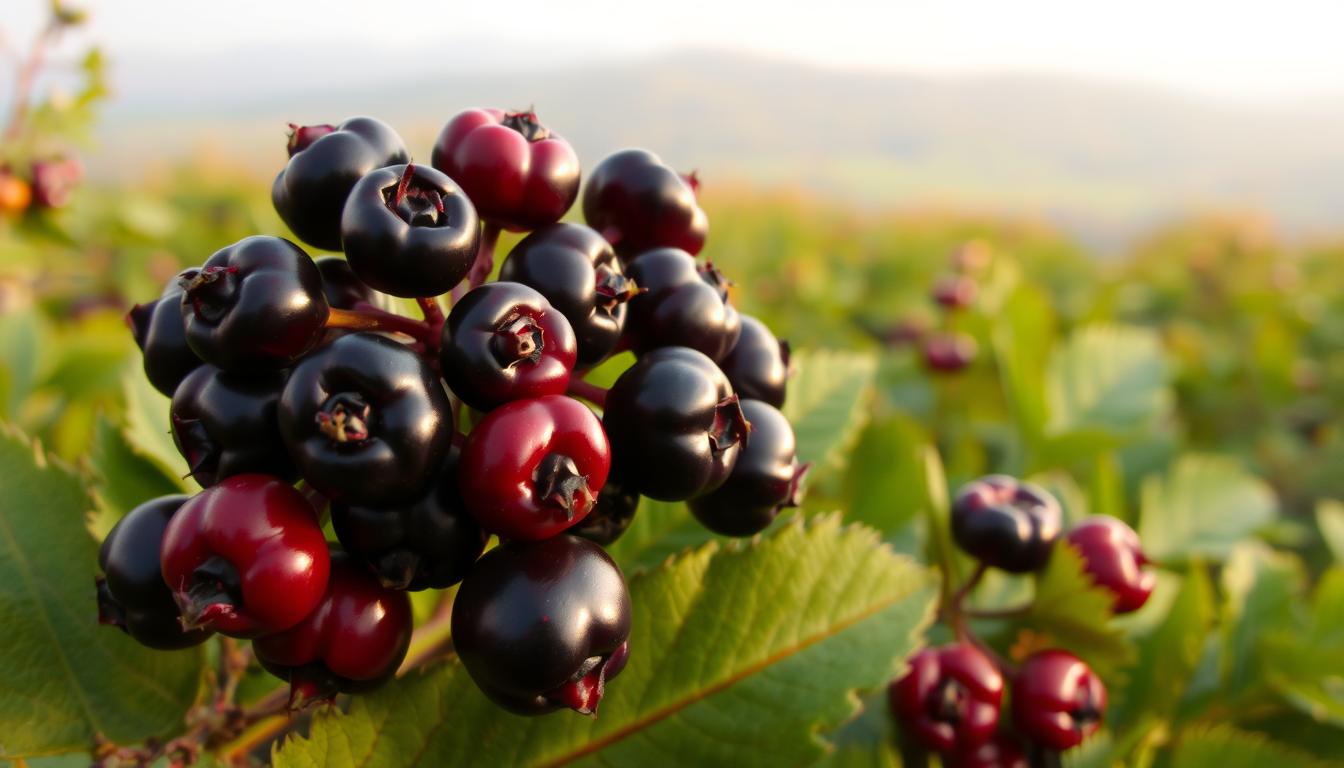It helps avoid serious health problems. We’ll look at the dangerous berries and what happens if you eat them.
Key Takeaways
- Not all wild berries are safe to eat; some can be deadly.
- Awareness of poisonous berries is essential for safe foraging.
- Education on toxic fruits can help prevent poisoning incidents.
- Identifying deadly berries can save lives.
- Immediate action is key in berry poisoning cases.
Introduction to Poisonous Berries
Wild berries are colorful and tempting to many. They draw people into nature’s beauty. But, an introduction to poisonous berries shows a big risk.
Some berries are safe, but others are very dangerous. They can make you very sick. It’s important to know the difference.
Knowing the risks of wild berries is key. Many poisonous berries look like safe ones. This makes it hard to tell them apart.
There are many berries out there, but some are very dangerous. This article will help you know which ones to avoid. It will make your outdoor adventures safer.
Understanding the Dangers of Wild Berries
Wild berries look tempting but can be dangerous. Many think all bright berries are safe. But, some berries have harmful compounds that can hurt your health.
Each berry type has its own toxins. Some have alkaloids that mess with your body. Others soak up bad stuff from the environment. Knowing this is key for safe foraging.
Eating the wrong berries can make you very sick fast. You might feel nauseous, vomit, or have stomach pain. Learning about berry dangers helps you stay safe while exploring nature.
5 Poisonous Berries That Could Possibly Kill You if Eaten
Knowing about poisonous berry overview is key for foragers and nature lovers. The five deadly berries we talk about are not just pretty. They have harmful stuff inside. Knowing about these dangers can keep you safe when you’re out in nature.
Overview of Each Berry
Here are five berries that are dangerous because they are toxic:
- Deadly Nightshade (Atropa belladonna): Small, black berries that grow in clusters. All parts of this plant are toxic, including the berries.
- American Black Cherry (Prunus serotina): The fruit looks good, but the leaves and bark have cyanogenic compounds.
- Foxglove (Digitalis purpurea): It has tubular flowers and seed pods. The berries are very dangerous.
- Rosary Pea (Abrus precatorius): It has very toxic seeds. Even one seed can be deadly if chewed.
- Taxus Baccata (Yew Berries): The berry’s flesh might look safe, but the seed inside is deadly.
Why These Berries Are Dangerous
The risks of toxic berries are big. Many of these berries have alkaloids or other harmful stuff. This can cause serious poisoning. Symptoms include nausea, vomiting, heart problems, and even breathing failure.
It’s important to be careful with wild berries. Make sure you know what they are before eating them. Watching animals and knowing which berries are bad can help keep you safe.
Deadly Nightshade (Atropa belladonna)
Deadly Nightshade, also known as Atropa belladonna, is very poisonous. It’s important to know how to spot it, mainly for those who love nature. Knowing how to identify Deadly Nightshade can keep you safe from poisoning.
Identifying Deadly Nightshade
Deadly Nightshade grows in woods and has purple flowers that look like bells. These flowers bloom in late spring to early summer. Its leaves are big, green, and wavy.
All parts of the plant, including the berries, are poisonous. The berries are shiny and purple. Knowing these signs helps you spot Deadly Nightshade.
Symptoms of Poisoning
When you eat Deadly Nightshade, you might feel very sick. You could get:
- Dilated pupils
- Sensitivity to light
- Blurred vision
- Confusion and hallucinations
- Tachycardia (rapid heartbeat)
Severe symptoms like breathing problems or seizures can happen too. Spotting these signs early is very important. It could save your life.
American Black Cherry (Prunus serotina)
The American Black Cherry, known as Prunus serotina, is a tree found in North America. It’s known for its striking look and dangers. This tree grows in mixed forests and does well in many places, from wetlands to dry areas.
The berries it makes are pretty, but be careful when trying to find black cherry. This is because some parts of the black cherry are toxic.
Characteristics of American Black Cherry
The American Black Cherry tree has long, serrated leaves and small, dark purple to black berries. Its bark is scaly and gets darker with age. Even though it’s beautiful, it has toxic parts.
The seeds and bark have cyanogenic compounds, which are harmful if eaten. While the fruit is okay in small amounts, eating too much can be dangerous. Symptoms of poisoning include nausea, trouble breathing, and dizziness. So, it’s important to be careful around this fruit.
- Identification features: Distinctive leaves, dark berries, scaly bark.
- Habitats: Mixed forests, wetlands, and dry ridge tops.
- Toxic parts of black cherry: Seeds and bark containing cyanogenic compounds.
Knowing about the American Black Cherry helps us enjoy its beauty safely. It’s important to know the risks so we can enjoy nature without harm.
Foxglove (Digitalis purpurea)
Foxglove, also known as Digitalis purpurea, has beautiful tubular flowers. But, it’s very poisonous. It can cause serious health problems. So, it’s important to know about foxglove toxicity.
The Beauties and Dangers of Foxglove
Foxglove is dangerous and needs to be identified correctly. It grows tall with purple flowers that look nice but are poisonous. Even a little bit can make you very sick.
Symptoms include nausea, vomiting, and heart problems. Knowing about foxglove is key to staying safe.
How Extensive the Poisoning Can Be
How bad foxglove poisoning is depends on how much you eat. Even a small bit can mess with your heart. It’s important to know about Digitalis purpurea to stay safe.
Teaching people how to spot foxglove helps keep everyone safe. It protects both people and pets from its dangers.
Rosary Pea (Abrus precatorius)
The Rosary Pea, known as Abrus precatorius, has beautiful red and black seeds. They look nice and are even made into jewelry. But, these seeds are very dangerous.
They contain a toxin called abrin. This toxin can cause serious poisoning. Just one seed can be deadly.
Symptoms of poisoning from abrin can show up fast. It’s important to be careful around this plant. Knowing about these seeds is key to keep kids and pets safe.
Taxus Baccata (Yew Berries)
Taxus Baccata, or the yew tree, is loved for its looks but also has dangers. Its toxic effects of yew are real. This evergreen shrub has dark green leaves and red berries called yew berries.
It’s important to know how to spot this plant. This keeps us safe outside.
Yew Berries and Their Toxic Effects
The toxic effects of yew come from its leaves and seeds. Eating them can be deadly. The red arils around the seeds look safe but are not.
Learning to identify Taxus Baccata is key. It’s a shrub or small tree with dark green leaves. Its bark is reddish-brown and scaly.
Knowing about these signs helps us stay safe outside. We can enjoy nature’s beauty without danger.
How to Recognize Poisonous Berries
It’s important to know which berries are safe to eat. A good guide helps you tell safe berries from poisonous ones. Look at the berry’s color. Bright colors like deep purple, bright red, or blue might mean it’s toxic.
Where berries grow can also tell you if they’re safe. Toxic berries often grow in damp places or near water. Look at the leaves and stems too. They can give you clues.
Use field guides with pictures and descriptions. This helps you spot poisonous berries. Be careful when touching berries you don’t know. Never eat a berry unless you’re sure it’s safe.
Here’s a quick guide to toxic berries:
| Berry Type | Color | Shape | Growth Habitat | Toxicity |
|---|---|---|---|---|
| Deadly Nightshade | Dark purple | Round | Wooded areas | Highly toxic |
| American Black Cherry | Black | Oval | Forest margins | Moderately toxic |
| Foxglove | Pink to purple | Bell-shaped | Woodlands | Easily toxic |
| Rosary Pea | Red with black seed | Round | Tropical regions | Extremely toxic |
| Yew Berries | Red | Oval | Gardens and parks | Potentially fatal |
By following these tips, you can learn more about berries. This makes foraging safer. Always be careful with berries you don’t know.

Safe Berries vs. Poisonous Berries
It’s important to know the difference between safe berries and poisonous ones. Safe berries are usually bright in color, the same size, and round or oval. Poisonous berries often look different, with irregular shapes or colors that blend in.
When checking if a berry is safe, look at the plant’s leaves, flowers, and how it grows. Safe berries grow on small plants. Poisonous ones might look like safe ones, making them hard to tell apart.
Learning about safe berries makes outdoor adventures better. Knowing what’s safe lets you enjoy foraging more. Paying attention to when and where berries grow helps you find the good ones.
The Importance of Education When Foraging
Learning about foraging is key to staying safe and having fun in nature. Not knowing about local plants can lead to bad experiences. This is true, even when trying to find edible berries.
Knowing about wild berries is very important. It helps you make smart choices when you’re out in nature. Knowing what berries are safe and which ones to avoid is very important.
Learning about foraging safety is also important. It helps you avoid poisonous plants. It also makes foraging more enjoyable. You can learn a lot by talking to experts and going to workshops.
First Aid for Berry Poisoning
Berry poisoning is very dangerous. It’s important to act fast. Knowing the right first aid can save lives. Here are the steps to take when someone has berry poisoning.
Immediate Steps to Take
- Don’t make them throw up. It can make things worse and cause choking.
- Try to find out what kind of berries they ate. This helps doctors treat them better.
- Watch them closely for signs like nausea, vomiting, belly pain, or feeling confused.
- If they can talk and are awake, tell them to drink water. It helps get rid of the poison.
When to Seek Medical Attention
Get medical help right away for berry poisoning. It’s very important to seek medical help for poisoning if you see these signs:
- Severe or ongoing vomiting
- Feeling confused or not right in the head
- Having trouble breathing
- Passing out
- Severe belly pain
Act fast if you see these signs. Being ready and knowing what to do can really help.

Conclusion
We’ve looked at poisonous berries and why they’re dangerous. Deadly Nightshade and Yew Berries are very toxic. This is why knowing about plants in the wild is key.
Remember, some berries are safe to eat, but others are not. This means we must be careful when picking berries. Knowing which ones are safe helps us enjoy nature without danger.
This article aims to make you safer and more aware of plants. It’s important to know about plants to enjoy nature safely. Always be careful and curious when you’re outside.
FAQ
What should I do if I suspect I’ve eaten a poisonous berry?
How can I identify poisonous berries?
Are all wild berries edible?
What are the symptoms of berry poisoning?
Can kids recognize poisonous berries?
Which berries are considered the most toxic?
Why is education important when foraging for berries?
How can I safely forage for berries?
When should I seek medical help for berry poisoning?
latest posts
- How to Make the Best Homemade White Wine with Fresh Grapes

- Cheddar gorge I was only expecting to find a cheese factory…

- Discover the Top 5 Worst Beaches to Visit in the World

- Fontwell Park: A Thrilling Day at the Races


